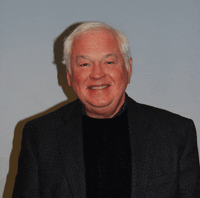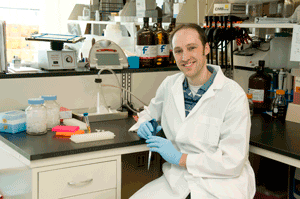Tyler Mayo is working in a DMU laboratory to help address potential vitamin A deficiency among children on the other side of the world.
When medical missionary and longtime DMU friend Jim Blessman, M.D., observed a high prevalence of vision problems among poor children in South Africa, he thought vitamin A deficiency could be the cause. He didn’t have a feasible way to test that, however, in the poverty-stricken areas he serves.
Enter DMU: After a conversation at commencement between Blessman and Bryan Larsen, Ph.D., dean of university research and biomedical graduate studies, Larsen approached DMU student Tyler Mayo, D.O.’12, who was interested in doing research relating to the eye. As a result, Mayo began seeking a way to test for vitamin A deficiency that was portable and less expensive than the prevailing method, high-performance liquid chromatography (HPLC).

That would be no small step: According to the World Health Organization, an estimated 250 million preschool children – mostly in poverty-stricken areas – are vitamin A deficient, a condition that can lead to blindness, severe illness and death. An estimated 250,000 to 500,000 vitamin A-deficient children become blind every year, half of them dying within 12 months of losing their sight.
In his research, Mayo came across the Bessey Lowry method, developed in the 1940s but eventually replaced by HPLC. The method uses a spectrometer, an instrument that used to be large and expensive but “now is smaller than a laptop,” he says. “I got the equipment put together so it could fit in a backpack or duffel bag.”

Mayo modified the method and is now testing its accuracy and consistency. He is comparing blood samples tested for vitamin A levels using his method and, by an external laboratory, using HPLC. If successful, the method could develop into a larger-scale study – and, eventually, be used by backpack-toting health care providers in poor areas around the world.
“The best part of research is problem-solving – to play with different approaches and come up with a solution that can be immediately used,” Mayo says. “The challenge is the tedious work of getting to that point.”


